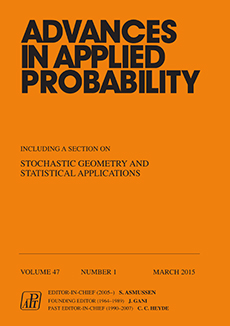Abstract
We study an M/G/1-type queueing model with the following additional feature. The server works continuously, at fixed speed, even if there are no service requirements. In the latter case, it is building up inventory, which can be interpreted as negative workload. At random times, with an intensity ω(x) when the inventory is at level x>0, the present inventory is removed, instantaneously reducing the inventory to 0. We study the steady-state distribution of the (positive and negative) workload levels for the cases ω(x) is constant and ω(x) = ax. The key tool is the Wiener–Hopf factorization technique. When ω(x) is constant, no specific assumptions will be made on the service requirement distribution. However, in the linear case, we need some algebraic hypotheses concerning the Laplace–Stieltjes transform of the service requirement distribution. Throughout the paper, we also study a closely related model arising from insurance risk theory.
Citation
Onno Boxma. Rim Essifi. Augustus J. E. M. Janssen. "A queueing/inventory and an insurance risk model." Adv. in Appl. Probab. 48 (4) 1139 - 1160, December 2016.
Information





